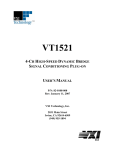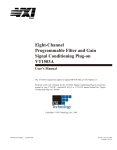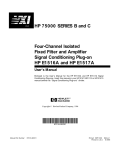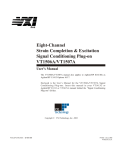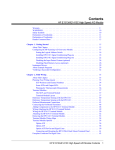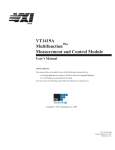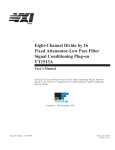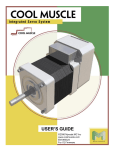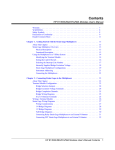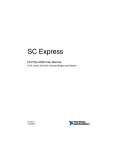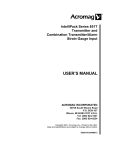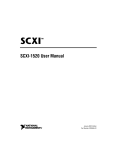Download Four-Channel Transient Strain Signal Conditioning
Transcript
bus Four-Channel Transient Strain Signal Conditioning Plug-on VT1511A User’s Manual The VT1511A manual also applies to Agilent/HP E1413B as Agilent/HP E1413 Option 21. Enclosed is the User’s Manual for the VT1511A Signal Conditioning Plug-on. Insert this manual in your VT1413C or Agilent/HP E1313 manual behind the “Signal Conditioning Plug-ons” divider. The VT1511A, Four-Channel Transient Strain SCP can be used with the VT1413C, VT1415A and the Agilent/HP E1313A and E1413B versions, but not with the Agilent/HP E1413A. Copyright © VXI Technology, Inc., 2003 Manual Part Number: 82-0085-000 Printed: July 9, 2003 Printed in U.S.A VT1511A Four-Channel Transient Strain Signal Conditioning Plug-on Introduction VT1511A is a double wide (i.e., takes the space of these two adjacent slots: 0-1, 2-3, 4-5, or 6-7) Signal Conditioning Plug-on (SCP) that provides 4 channels of strain measurements for the VT1413C High Speed A/D Module. The SCP provides 4 channels of Strain Completion Circuitry and Excitation Voltages, a programmable filter, and makes the strain measurements on 4 channels using the Sample and Hold method. The SCP provides the strain completion circuitry and the Sample and Hold circuitry. The SCP can be wired for measuring the Excitation Voltage at the bridge connection (Remote Sense) or locally on the Terminal Module. Note The VT1511A, Four-Channel Transient Strain SCP can be used with the VT1413C, VT1415A and the Agilent/HP E1313A and E1413B versions, but not with the Agilent/HP E1413A. About This Manual Except where noted, references to the VT1413C also aply to the VT1415C and Agilent/HP E1313. This manual shows how to connect to the Terminal Module for sample/hold strain measurements, and also shows how to control the Option 21 Signal Conditioning Plug-on (SCP) using SCPI commands and Register-Based commands. The following also explains the capabilities of the SCP and gives the specifications. The manual contents is: · · · · · · · Introduction VT1511A Operation . . . . . . . . . . . . . . . . . . . . . . . . . . . . . . 4 Selecting the 1/4 Bridge and 120/350 Ohm Jumpers . . . . . . . . . . . . . 7 Connecting To The Terminal Module . . . . . . . . . . . . . . . . . . . . . 8 Programming With SCPI Commands . . . . . . . . . . . . . . . . . . . . 14 Using External Excitation Voltages . . . . . . . . . . . . . . . . . . . . . 20 Register-Based Programming . . . . . . . . . . . . . . . . . . . . . . . . 22 Specifications . . . . . . . . . . . . . . . . . . . . . . . . . . . . . . . . . 24 VT1511A Transient Strain SCP 3 VT1511A Operation There are two circuits on the VT1511A SCP, one circuit provides the Bridge Excitation Voltage and Bridge Completion circuitry, and the other circuit provides the sample and hold measurement circuitry. The completion circuitry can output a Bridge Excitation voltage of 0 V, 1 V, 2 V, 5 V or 10 V on each channel. Note The 10 V Excitation level can not be used with a 120 W Full Bridge configuration. This low impedance bridge configuration draws too much current from the excitation supply at 10 V (>50 mA supply limit). The measurement circuitry provides the measurement path to the VT1413C for both the excitation voltage and the output voltage of the strain gage bridge. The VT1413C measures the excitation voltage during calibration and measures the bridge output voltage during a measurement cycle. The measurement circuitry samples all channels simultaneously and thus reduces the skew introduced by scanning. The amount of skew removed depends on the cutoff frequency setting of the lowpass Filter (see next paragraph). When reducing the filter bandwidth, the propagation delay increases between the channels which causes a larger delay between channels programmed to the same bandwidth (see specifications for delay values). The circuitry provides a voltage gain of 0.5, 8, 64 or 512 for each bridge output measurement channel. The SCP also has a lowpass Filter on each bridge output measurement channel. The filter is a 6th order Bessel Active RC filter used to provide alias protection and noise reduction. The filter cutoff frequencies are 1 kHz, 500 Hz, 250 Hz, 100 Hz and 15 Hz. There are two ways the VT1413C can measure the excitation voltage while calibrating the SCP. One way measures the voltages at the bridge connections (remote sense) and the other way measure the voltage locally at the connections in the Terminal Module. The remote sense is more accurate, but requires extra wiring to the bridge. Figures 1, 2 and 3 show examples of a typical 1/4 Bridge, 1/2 Bridge, and Full Bridge strain gage measurement, respectively. The figures also show the calibration shunt resistor connects to the bridge. When shunt calibration is enabled, the shunt resistor is switched in parallel to one leg of the bridge. This causes a change in the bridge output voltage. Use it to check the bridge wiring. 4 VT1511A Transient Strain SCP VT1511A Operation Figure 1. Typical 1/4 Bridge Measurement Figure 2. Typical 1/2 Bridge Measurement VT1511A Operation VT1511A Transient Strain SCP 5 Figure 3. Typical Full Bridge Measurement 6 VT1511A Transient Strain SCP VT1511A Operation Selecting the 1/4 Bridge and 120/350 Ohm Jumpers Figure 4 shows how to select the 1/4 Bridge Jumper and how to select for either 120 W or 350 W bridges. Figure 4. Selecting the 1/4 Bridge and 120/350 Ohm Jumpers Selecting the 1/4 Bridge and 120/350 Ohm Jumpers VT1511A Transient Strain SCP 7 Connecting To The Terminal Module This section shows how to make 1/4, 1/2. and Full Bridge strain gage connections to the Terminal Module. The SCP connections for the Terminal Modules are shown on the stick-on labels that came with the SCP. Use the appropriate label for the type of Terminal Module you have. The connections and appropriate stickers are as follows: · For VT1413C and above Terminal Modules, use stickers for VT1510A SCPs. The connections are shown in Figure 5. · For Agilent/HP E1313 Terminal Moduless, use stickers for VT1510A SCPs. The connections are shown in Figures 6 and 7. · For Agilent/HP E1413B and below Terminal Modules, use stickers for Agilent/HP E1413 Option 20 SCPs. The connections are shown in Figure 8. Figure 5 VT1511A C-Size Terminal Module Connections 8 VT1511A Transient Strain SCP Connecting To The Terminal Module Figure 6 VT1511A B-size Terminal Module Connections (Ch 00-31) Figure 7 VT1511A B-size Terminal Module Connections (Ch 32-63) Figure 8 Agilent/HP E1413 Option 21 Terminal Module Connections Connecting To The Terminal Module VT1511A Transient Strain SCP 9 Wiring the Terminal Module · See “Attaching and Wiring the Terminal Module” in the VT1413C User’s Manual to wire the strain gages to the Terminal Module. · For accurate measurements, use a twisted shielded cable for the strain gage connections. Connect the shield to the specimen and to the guard (G) terminal on the Terminal Module. Note The following figures in this section show the connections using SCP 0 as the Strain SCP and SCP 1 as the Direct Input SCP. Use the same technique using other SCPs and other channel numbers. For example, for a Channel 00 H and L connection on SCP 0, connect to H and L on Channel 57 for SCP 7. See “Opening and Wiring the Terminal Module” in the VT1413C User’s Manual to wire the strain gages to the Terminal Module. 1/4 Bridge Connections Use Figure 9 for 1/4 Bridge connections to the Terminal Module. Install or make sure the 1/4 Bridge Jumper(s) is installed in the 1/4 Bridge configuration for all channels that are to make 1/4 Bridge measurements (see Figure 4). Transient Strain SCP (0-1) Note The optional Shunt Resistor connection is shown by the dashed lines Sample Shielded Cable Figure 9. Typical 1/4 Bridge Connections 10 VT1511A Transient Strain SCP Connecting To The Terminal Module 1/2 Bridge Connections Use Figure 10 for 1/2 Bridge connections to the Terminal Module. Remove or be sure the 1/4 Bridge Jumper(s) is not installed in the 1/4 Bridge configuration for all channels that are to make 1/2 Bridge measurements (see Figure 4). Figure 10. Typical 1/2 Bridge Connections Connecting To The Terminal Module VT1511A Transient Strain SCP 11 Full Bridge Connections Use Figures 11 and 12 for Full Bridge connections to the Terminal Module. Remove or be sure the 1/4 Bridge Jumper(s) is not installed in the 1/4 Bridge configuration for all channels that are to make Full Bridge measurements (see Figure 4). Figure 11. Typical Full Bridge Connections 12 VT1511A Transient Strain SCP Connecting To The Terminal Module Figure 12. Typical Full Bridge Connections (Cont.) Connecting To The Terminal Module VT1511A Transient Strain SCP 13 Programming With SCPI Commands The following SCPI commands verify the SCP types installed in the VT1413C and how to program the VT1413C for strain measurements using VT1511A SCPs. The commands listed in this section are below and also in Chapter 5 of the VT1413C User’s Manual. SCPI Commands Used The following table lists all commands used in this section of the manual. Command Description CALibration:TARE (@<ch_list>) calibrates SCP on specified channels CALibration:TARE? returns calibration value INPut:FILTer[:LPASs]:FREQuency <cutoff_freq>,(@ch_list>) selects the SCP’s low pass filter cufoff frequency INPut:GAIN <chan_gain>5,(@<ch_list>) selects the sample and hold gain INPut:LOW FLOat | WVOLtage,(@<ch_list>) selects the sample & hold amplifier input connection OUTPut:VOLTage:AMPLitude <amplitude>,(@ch_list>) selects the excitation voltage value [SENSe:]FUNCtion:STRain:FBPoisson [<range>,](@<ch_list>) selects the range for the full bridge bending poisson EU conversion [SENSe:[FUNCtion:STRain[:QUARter] [<range>,](@<ch_list>) selects the range for quarter bridge EU conversion [SENSe:]STRain:GFACtor <gage_factor>,(@<ch_list>) selects the strain gage factor [SENSe:]STRain:POISson <poisson_ratio>,(@<ch_list>) selects the poisson ratio SYSTem:CTYPe? (@<channel>) returns the SCP type Checking the ID of the SCP Use the “SYSTem:CTYPe? (@<channel>)” command to verify the SCP type(s) in the VT1413C. · The channel parameter specifies a single channel in the channel range covered by the SCP of interest. The first channel numbers for each of the SCP positions are: 0, 16, 32 and 48, if all SCPs are VT1511A SCPs. The value returned for the SCP in an Agilent/HP E1413B is: HEWLETT-PACKARD, E1413 Opt 21 4-Ch S/H-Strain Bridge Completion SCP,,0 The value returned for the SCP in a VT1413C or Agilent/HP E1313A is: HEWLETT-PACKARD, E1511 4-Ch S/H-Strain Bridge Completion SCP,,0 To determine the type of SCP installed on channels 0 through 7, send: 14 VT1511A Transient Strain SCP SYST:CTYP? (@100) query SCP type @ ch 0 enter statement here enter response string Programming With SCPI Commands Making 1/4 Bridge Measurements The following example shows how to make 1/4 Bridge measurements using channels 0 through 3. Be sure to set the jumper for the 1/4 Bridge configuration (see Figure 4). Bridge is Unstrained The following commands select the excitation voltage and specifies the parameters to convert strain gage readings for the specified channels. Do this when the bridge is in the Unstrained configuration. The commands are separated into two parts. The first part configures and calibrates the excitation/completion circuitry. The second part configures the module for strain measurements. Execute these commands when the bridge is in the Unstrained configuration. Setup and Calibrate Excitation/Completion Circuitry OUTP:VOLT:AMPL 1,(@100:103) select the excitation voltage value for channels 0 - 3 (default is 0 V) INP:LOW WVOL,(@100:103) selects the Wagner voltage input INP:FILT:FREQ 1000,(@100:103) selects the sample and hold lowpass filter frequency (default is 15 Hz) INP:GAIN 8,(@100:103) selects the gain of the sample and hold circuitry (default is 0.5) CAL:TARE (@100:103) measure the unstrained voltage on channels 0-3 CAL:TARE? to return the success flag from the CAL:TARE operation enter CAL:TARE query wait until success flag from CAL:TARE operation is returned Configure the Measurement STR:GFAC 2,(@100:103) specifies the gage factor on channels 0-3 (selected factor 2 is the default value) FUNC:STR:QUAR 1,(@100:103) link channels 0-3 to EU conversion for strain measurement (selected 1V range value is the default value) Bridge is Strained When the bridge is in the Strained configuration and the measurements are to be made, scan the selected channels and make the measurements. Use the VT1413C’s INITiate and TRIGger commands to make the strain measurement. You must define what triggers, etc., to use to make the measurements (see the “VT1413C User’s Manual” for information). Programming With SCPI Commands VT1511A Transient Strain SCP 15 Making Full Bending Poisson Bridge Measurements The following example shows how to make Full Bridge Bending Poisson Bridge measurements using channels 0 through 3. Be sure to set the jumper for the 1/2 or Full Bridge configuration (see Figure 4). Bridge is Unstrained The following commands select the excitation voltage and specifies the parameters to convert strain gage readings for the specified channels. Do this when the bridge is in the Unstrained configuration. The commands are separated into two parts. The first part configures and calibrates the excitation/completion circuitry. The second part configures the module for strain measurements. Execute these commands when the bridge is in the Unstrained configuration. Setup and Calibrate Excitation/Completion Circuitry OUTP:VOLT:AMPL 1,(@100:103) select the excitation voltage value for channels 0-3 (default is 0 V) INP:LOW FLO,(@100:103) selects the floating input INP:FILT:FREQ 1000,(@100:103) selects the sample and hold lowpass filter frequency (default is 15 Hz) INP:GAIN 8,(@100:103) selects the gain of the sample and hold circuitry (default is 0.5) CAL:TARE (@100:103) measure the unstrained voltage on channels 0-3 CAL:TARE? to return the success flag from the CAL:TARE operation enter CAL:TARE query wait until success flag from CAL:TARE operation is returned Configure the Measurement STR:GFAC 2,(@100:103) specifies the gage factor on channels 0-3 (selected factor 2 is the default value) STR:POIS .3,(@100:103) set Poisson ratio for EU conversion; selected value is 0.3 (default value) FUNC:STR:FBP 1,(@100:103) link channel 0-3 to EU conversion for strain measurement; selected voltage range is 1 V Bridge is Strained When the bridge is in the Strained configuration and the measurements are to be made, scan the selected channels and make the measurements. Use the VT1413C’s INITiate and TRIGger commands to make the strain measurement. You must define what triggers, etc., to use to make the measurements (see the “VT1413C User’s Manual” for information). 16 VT1511A Transient Strain SCP Programming With SCPI Commands Comments The following explains the commands used in strain measurements. How to Link EU The following explains the commands that link the strain EU conversion with the Conversions to specified channels. The commands tell the VT1413C to use the EU conversion for Channels strain measurements. The VT1413C performs the appropriate EU conversion (e.g., 1/4 Bridge measurements) depending on the command used. Thus, each bridge configuration has its own command with the command used for the 1/4 Bridge configuration as the default value. (See “Linking Channels with EU Conversion” in Chapter 3 of the VT1413C User’s Manual.) The syntax of a typical command is: [SENse:]FUNCtion:STRain:HBENding [<range>,](@<ch_list>) where <range>> is the voltage range of the VT1413C (default value or no specified parameter is AUTO) and <ch_list> specifies the channels. The different bridge types and corresponding EU to Channels Linking commands are in the following table. Bridge Type Command Full Bending Bridge [SENse:]FUNCtion:STRain:FBENding Full Bending Poisson Bridge [SENse:]FUNCtion:STRain:FBPoisson Full Poisson Bridge [SENse:]FUNCtion:STRain:FPOisson 1/2 Bending Bridge [SENse:]FUNCtion:STRain:HBENding 1/2 Poisson Bridge [SENse:]FUNCtion:STRain:HPOisson 1/4 Bridge [SENse:]FUNCtion:STRain[:QUARter] Notes 1. The strain readings from the VT1413C are output as micro strain (µe) units. 2. Because of the number of possible strain gage configurations, the driver must generate any Strain EU conversion tables and download them to the instrument when INITiate is executed. This can cause the time to complete the INIT command to exceed 1 minute. Purpose of Channel The CALibration:TARE command measures the voltage across the bridge to Tare Calibration determine the unstrained voltage value of the bridge. This corrects for the offset (CAL:TARE) voltage across the bridge when in the Unstrained configuration. The command automatically executes the CAL? command and thus calibrates the internal excitation supply. Programming With SCPI Commands VT1511A Transient Strain SCP 17 The VT1413C uses the unstrained reading (i.e., offset voltage) in conjunction with the strain gage factor (see “Purpose of the Strain Gage Factor Command (STR:GFAC)” below) to calculate the strain measurements. You normally perform both operations before making the actual strain measurements. Instead of using CAL:TARE, you can use the [SENSe:]STRain:UNSTrained command to enter the unstrained voltage. In this case you must measure and enter the offset voltage of the bridge, when the bridge is Unstrained. The command syntax is: [SENSe:]STRain:UNSTrained <unstrained_v>,(@<ch_list>) where <unstrained_v> is the voltage value of the bridge in the unstrained position (default is 0V) and <ch_list> specifies the channels to be measured. Purpose of the Strain The [SENse:]STRain:GFACtor command specifies the gage factor to be used by the Gage Factor Command VT1413C to calculate the strain measurements. The default value of the command is a (STR:GFAC) factor of 2. The command syntax is: [SENse:]STRain:GFACtor <gage_factor>,(@<ch_list>) where <gage_factor> is the gage factor value (default is 2) and <ch_list> specifies the channels to be measured. Purpose of the Poisson The [SENse:]STRain:POISson command sets the Poisson ratio to be used by the Ratio Command VT1413C for EU conversion of strain values measured (see “Linking Channels with EU (STR:POIS) Conversion” in Chapter 3 of the VT1413C User’s Manual). This command is only needed if making Poisson strain measurements. It is not needed for making 1/4 Bridge, or 1/2 or Full Bridge Bending measurements. The default value of the command is .3. The command syntax is: [SENse:]STRain:POISson <poisson_ratio>,(@<ch_list>) where <poisson_ratio> is the Poisson ratio (default is 2) and <ch_list> specifies the channels to be measured. Connecting the Sample For 1/4 and 1/2 Bridge configurations, the low input of the sample and hold input and Hold Amplifier amplifier should be connected to the negative side of the internal bridge connection on Input (INPut:LOW) the SCP itself. This is done by a switch on the SCP which provides the Wagner voltage for the bridge (see Figures 1 and 2). For Full Bridge configuration, the low input of the sample and hold amplifier should be externally connected to the negative side of the bridge. The amplifier input must not be connected to the internal bridge (see Figure 3). Use the following command for either configuration: INPut:LOW <volt_type>,<@ch_list> 18 VT1511A Transient Strain SCP Programming With SCPI Commands where <volt_type> can be either FLOat for a floating input (Full Bridge configuration) or WVoltage for a Wagner Voltage connection (1/4 and 1/2 Bridge configurations). respectively, and <@ch_list> specifies the channels. Using The Shunt Resistor To check if the bridge is operational, you can add a 29.4 kW Shunt resistor across one leg of the bridge, as illustrated in Figure 13. A FET switch adds or removes the resistor. When the resistor is added, it changes the unstrained offset voltage on the bridge. The resistor can only affect the bridge balance as long as you follow the connections shown in the dotted lines in Figures 1, 2 and 3, or as shown in Figure 13. Use the OUTPut:SHUNt command to add or remove the resistor from the bridge. The syntax of the command is: OUTPut:SHUNt 1 | 0 | ON | OFF + + 1/4 Bridge Strain Gage 350W RB RS 120W X01 Strain Gage RB X02 X03 Bridge Completion Full Bridge Strain Gage X04 Strain Gage 29.4kW Strain Gage RS X01 120W X02 X03 Bridge Completion X04 29.4kW Shunt Shunt FET Switch Current Flow 350W Current Flow FET Switch + 1/2 Bridge Strain Gage RB 350W X01 120W X02 X03 Bridge Completion Strain Gage RS Note The current must flow into the Shunt Resistor, as shown by the arrows X04 29.4kW Shunt Current Flow FET Switch OUTPut:SHUNt ON Figure 13. Adding the Shunt Resistor Using The Shunt Resistor VT1511A Transient Strain SCP 19 Using External Excitation Voltages You can use your own external excitation voltage instead of using the internal voltage of the SCP. If using an external voltage, you must: · use your own bridge completion circuitry · isolate the internal excitation supply from the bridge · enter the value of the excitation voltage into the VT1413C so it can make the correct EU conversions for strain measurements Connecting the External Supply Use Figure 14 to connect the external supply to the Terminal Module. Be sure not to connect the external excitation voltage to the “E+” and “E-” terminals. Enter Excitation Voltage Value Use the [SENSe:]STRain:EXCitation command to enter the value of the external excitation voltage. The syntax for the command is: [SENSe:]STRain:EXCitation <excite_v>,(@<ch_list>) where <excite_v> is the value of the external excitation voltage and <ch_list> specifies the measurement channels of the SCP. The default value of the excitation voltage is 3.9 V, the minimum allowable voltage value that can be entered is 0.01 V, and the maximum value that can be entered is 99. However, the maximum allowable input voltage of the Sample and Hold Input Amplifier is 16V which may limit the maximum Excitaion Voltage to 16 V. 20 VT1511A Transient Strain SCP Using External Excitation Voltages Transient Strain SCP (0-1) Poisson Full Bridge Top Sample Note The optional Shunt Resistor connection is shown by the dashed lines Bottom Sample Shield [SENSe:]STRain:EXCitation <excite_v>,(@<ch_list>) External Excitation Voltage Figure 14. Connecting External Excitation Voltages Using External Excitation Voltages VT1511A Transient Strain SCP 21 Register-Based Programming Appendix D of the VT1413C User’s Manual covers the Register-Based commands shown below. You should read that appendix to become familiar with accessing registers and executing Register-Based commands. This section relates those commands to the parameter values that are specified for this SCP. When Register Programming an SCP, most communication is through the Signal Conditioning Bus. For that you will use the Register Commands: SCPWRITE <regaddr> <regvalue> and SCPREAD? <regaddr> Read (returned value) Write (<regvalue>) SCP Register* <regaddr> Value Whole SCP Reg 0 00ppp000000 2 Whole SCP Reg 1 00ppp000001 2 Channel Reg 0 01pppccc0002 Channel Gain (Sample and Hold channels): (FFFF16=0.5, FFF116=8, FFF216=64, FFF316=512) Channel Gain (direct channels): 000016=1 Channel Reg 1 01pppccc0012 Channel Frequency: (XXX016=15Hz, XXX116=100Hz, XXX216=250Hz, XXX316=500Hz, XXX416=1kHz) Channel Reg 2 01pppccc0102 SCP ID (source) - Opt 21: (610016) SCP Gain Scale - (XXX316) Excitation, Wagner Voltage, and Shunt Cal Resistor: Data format is XEVVVVWS2 where: X=don’t care E=enable excitation voltage 1=on, 0=off V=Excit. V bits, 00012=1V, 00102=2V, 01002=5V, 10002=10V W=Wagner Voltage to LO, 1=connected, 0=disconnected S=Shunt Cal Resistor, 1=in circuit, 0=out X=don’t care ppp=Plug-on ccc=SCP channel * see the SCPWRITE and SCPREAD? commands in Appendix D to learn more on how to read the SCP regisaters. Checking the ID of the SCP 22 VT1511A Transient Strain SCP To query an SCP for its ID value, write the following value to Parameter Register 1: ( SCP number ) ´ 4016 Then write the opcode for SCPREAD? (080016) to the Command Register. The ID value will be written to the Response Register. Read the Response Register for the value. Register-Based Programming Setting the Filter Cutoff Frequency To set the filter cutoff frequency for an SCP channel, write the following SCP channel address to Parameter Register 1: 20016 + (SCP number) x 4016 + (SCP channel number) x 816 + 216 Write one of the following cutoff values to Parameter Register 2: 000016 for 15 Hz, 000116 for 100 Hz, 000216 for 250 Hz, 000316 for 500 Hz, 000416 for 1 kHz Then write the opcode for SCBWRITE (0810 16) to the Command Register. Setting the Channel Gain To set the amplifier gain for an SCP channel, write the following SCP channel address to Parameter Register 1: 20016 + (SCP number) x 4016 + (SCP channel number) x 816 + 116 Write one of the following gain values to Parameter Register 2: FFFF16 for 0.5, FFF116 for 8, FFF216 for 64, FFF316 for 512 Then write the opcode for SCBWRITE (0810 16) to the Command Register. Setting the Channel Excitation Voltage To set the excitation voltage for an SCP channel, write the following SCP channel address to Parameter Register 1: 20016 + (SCP number) x 4016 + (SCP channel number) x 816 Write one of the following values to Parameter Register 2: FF0016 for 0 V, FF4416 for 1 V, FF4816 for 2 V, FF5016 for 5 V, or FF6016 for 10 V Then write the opcode for SCBWRITE (081016) to the Command Register. The values above will set the stated excitation values as well as the default state for the channel’s Wagner Ground and Cal Shunt Resistor (both disconnected). Controlling Wagner Ground To connect the Wagner Voltage to the LO terminal, simply add the value 000216 to the Excitation Voltage code sent in the procedure above. Controlling Cal Shunt Resistors To shunt the bridge with the Cal Resistor, add the value 000116 to the Excitation Voltage code sent in the procedure above. Register-Based Programming VT1511A Transient Strain SCP 23 Specifications SCP Current Requirements (Amps) 5Vmax 24Vtyp 24Vmax -24Vtyp 0.55 0.014 0.015 0.013 -24Vmax 0.015 Voltage Measurements Accuracy: Gain of X0.5 Range ±FS Gain error Offset error Noise 3 sigma 125 mV 0.02 488 µV 1.5 mV 0.5 mV 0.02 488 µV 1.5 mV 2.0 V 0.02 488 µV 1.5 mV 8.0 V 0.02 488 µV 1.5 mV Temperature coefficients Gain: 10 ppm/°C (after *CAL) Offset: add tempco error to above table Temp Tempco (0 - 30) 0 µV/°C (30 - 55) 0.75 µV/°C Accuracy: Gain of X8 Range ±FS Gain error Offset error Noise 3 sigma 7.8 mV 0.02 30.5 µV 95 µV 31.25 mV 0.02 30.5 µV 95 µV 125 mV 0.02 30.5 µV 95 µV 0.5 V 0.02 30.5 µV 95 µV Temperature coefficients Gain: 10 ppm/°C (after *CAL) Offset: add tempco error to above table 24 VT1511A Transient Strain SCP Temp Tempco (0 - 30) 0 µV/°C (30 - 55) 0.75 µV/°C Specifications Accuracy: Gain of X64 Range ±FS Gain error Offset error Noise 3 sigma 3.9 mV 0.02 15.0 µV 12 µV 15.6 mV 0.02 15.0 µV 12 µV 62.5 mV 0.02 15.0 µV 12 µV Temperature coefficients Gain: 10 ppm/°C (after *CAL) Offset: add tempco error to above table Temp Tempco (0 - 40) 0.14 µV/°C (40 - 55) 0.38 µV/°C Accuracy: Gain of X512 Range ±FS Gain error Offset error Noise 3 sigma 7.81 mV 0.04 15 µV 2 µV Temperature coefficients Gain: 10 ppm/°C (after *CAL) Offset: add tempco error to above table Specifications Temp Tempco (0 - 40) 0.14 µV/°C (40 - 55) 0.38 µV/°C VT1511A Transient Strain SCP 25 Filter Characteristics Normal mode rejection: 15 Hz lowpass filter (6 pole Bessel) 15 Hz -3 dB 50 Hz >33 dB 60 Hz >43 dB 100 Hz lowpass filter (6 pole Bessel) 100 Hz -3 dB 400 Hz > 43 dB 250 Hz lowpass filter (6 pole Bessel) 250 Hz -3 dB 1000 Hz >43 dB 500 Hz lowpass filter (6 pole Bessel) 500 Hz -3 dB 2000 Hz >43 dB 1000 Hz lowpass filter (6 pole Bessel) 1000 Hz -3 dB 4000 Hz >43 dB Sample time skew between channels: Because the lowpass filter precedes the sample and hold, the interchannel sample time skew is primarily determined by the matching of the filter propagation delay times. The table below lists the propagation delay for a step function input (measured at 50% of the final value) for each filter setting, as well as the matching between channels programmed to the same filter setting. Bandwidth Step Propagation Delay (nominal) Delay Matching (± from nominal) 1 kHz 427.5 µs 10 µs 500 Hz 854.9 µsec 20 µs 250 Hz 1.710 ms 40 µs 100 Hz 4.275 ms 100 µs 15 Hz 28.50 ms 670 µs Maximum filter overshoot: < 1% of input step size 26 VT1511A Transient Strain SCP Specifications Common mode rejection (0 to 60 Hz): X0.5 gain > 60 dB X8 gain >78 dB X64 gain >100 dB X512 gain >100 dB Maximum input voltage: normal mode plus common mode Operating: <±16 V peak Damage level: >±42 V peak Maximum common mode voltage: Operating: <±16 V peak Damage level: >±42 V peak Crosstalk (referenced to input): 350 W source, DC to 1 kHz <80 dB -20 log (receiving channel input/source channel gain ) e.g., crosstalk from channel at gain of 0.5 to channel at gain 512: <-80 dB -20 log (512/0.5) = -140 dB Input impedance: >100 MW Maximum tare cal offset: X0.5 gain ±25% of full scale X8 gain ±90 mV X64 gain ±95 mV X512 gain ±95 mV Specifications VT1511A Transient Strain SCP 27 Sample and Hold Characteristics Acquisition Time: 1 µs Aperature Time: 2 ns Aperature Delay: 35 ns + delay in skew specification Aperature Jitter: 150 ps Droop Rate: 1 Volt/s @ 50ºC. Typical is 2-3 mV/s @25ºC. This is referenced to the SCP output so divide by SCP gain setting. 28 VT1511A Transient Strain SCP Specifications Specifications VT1511A Transient Strain SCP 29 30 VT1511A Transient Strain SCP Specifications Specifications VT1511A Transient Strain SCP 31 32 VT1511A Transient Strain SCP Specifications Specifications VT1511A Transient Strain SCP 33 34 VT1511A Transient Strain SCP Specifications




































